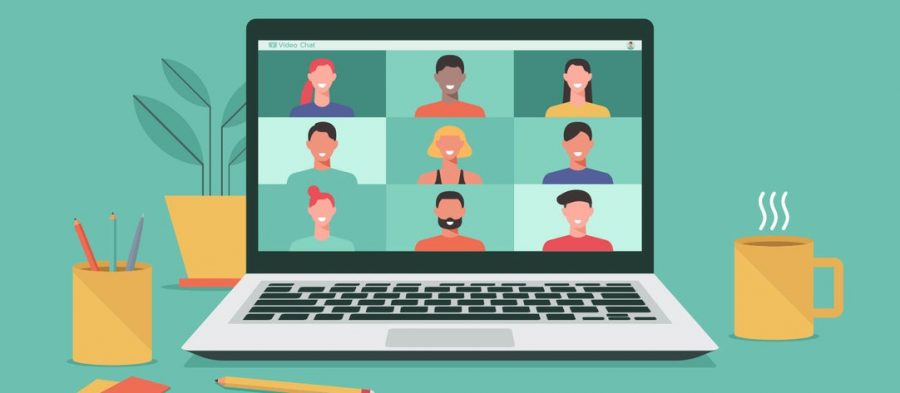Is the Distance Learning Workload Excessive? Students and Teachers Weigh In
October 29, 2020
The switch to online learning that the Tracy Unified School District made in response to the Coronavirus pandemic entirely altered teaching methodology. Students and teachers have concerns about this.

Tracy High School conducts its distance learning over Microsoft Teams, and most students are in class every day for three hours of synchronous, or in-person, learning. Asynchronous, or individual learning, follows synchronous learning and extends to 3:30 p.m.
Still, students like senior Mysha Mamsa feel that the additional free time they are receiving to complete schoolwork is not sustainable to support the amount of work assigned.
“Even though we have so much time, we also have so much more work. I sit in front of my computer from 7 a.m. to 11 a.m., then take an hour break and then go back to doing homework and studying from about 12 to midnight. It is outrageous the amount of work we are receiving,” Mamsa said.
Senior Kyle Vergara feels that the amount of work assigned to him is needless on top of the work he does to learn the material outside of school.
“Considering that we often don’t have the time for actual lectures in class, we tend to be stuck with the task of individually learning the work by ourselves. To be stuck with more than three hours of homework afterward is unnecessary,” said Vergara.
Marvin Melendez, another senior, had little to say except, “It’s simply just too much.”

Margaret Fagbolu, a senior at Millennium Charter School, is having a different experience than Tracy High Students. “[Distance learning] hasn’t actually been too bad,” she said. “Since I am a senior, I have a lot less classes. I only have two classes, a college class and an internship class. The internship class is only one day a week and the college class is just assigned work and I do it when I find time.”
But Fagbolu acknowledges how important it is for students to receive the support that they need. “Schools should put mental health into consideration during times like these a bit more!” she added.
Mamsa shares this value. “This is hurting my back and my eyes but most importantly my mental health, and I know many students feel the same,” she said about learning online with Tracy High.
As the school’s IB coordinator, IB Psychology teacher and Theory of Knowledge 11 and 12 teacher, Rachel Hermann has experienced the effects of distance learning from multiple lenses. But regarding student’s feelings about the workload, she feels that this depends on a variety of variables and is different from student to student.
“I’m not in a good position to judge, because I don’t know how much other IB teachers are giving. I know how much I’m giving and I hope that it isn’t too much, but it’s hard for me to gauge even as a teacher because we don’t see students every day,” Hermann said.
She also shared insight on the challenges of distance learning from a teacher’s perspective. One issue that teachers are facing as a result of distance learning is that it is harder to maintain a teacher-student dialogue. This affects the amount of work that they assign as well as their perceptions regarding its intensity.
“We’re not really aware of how long it takes students to do some of the assignments we’re giving. We might think it only takes ten minutes, but it might be taking students forty minutes.” During this time especially, it is important that teachers and students are able to have conversations. Hermann added that “A teacher cannot fix something or make adjustments if they don’t know. We can’t address something if we don’t know that it’s a concern.”
She hopes that students will ask their teachers for help when they need it. “I would encourage students to reach out to their teachers directly if they have concerns about the workload that they are given, and if it’s an IB class, to bring those concerns to me and I would be more than willing to talk with you and be a sounding board as the coordinator of the program. I hope that teachers are receptive to listening to the needs of the student,” said Hermann.
On top of the concerns that teachers have about the lack of communication with their students, Coronavirus safety procedures have changed the manner and frequency of teacher interactions.
“It’s hard because we are in our own classrooms and we’re not supposed to be congregating, and I’m talking to teachers far less than I normally would. Even though I’m on campus with them, I don’t see them. Overall, teachers are talking with each other less, so I do not know what other teachers are doing,” Hermann said. This makes it more challenging for teachers to coordinate the amount of work that they are assigning.
And teachers are also faced with navigating Microsoft Teams, a system that is entirely new to them. Hermann teaches online classes outside of Tracy High and is experienced with different LMS, or Learning Management Systems. But Teams is not as user-friendly as teachers like herself hoped for.
“Honestly, it’s hard for a teacher to help students in distance learning when we’re trying to learn the system ourselves,” Hermann said.
But she also acknowledges that impromptu distance learning is not the same as when students specifically sign up for one of her online classes.
“One of the biggest differences is, when a student has signed up for an online class, they willingly and intentionally sign up for an online class. They knew what they were getting into, that online learning requires much higher levels of reading comprehension, self-motivation and pacing,” Hermann said.
But she added, “For you guys, you did not sign up for distance learning, and so I am appreciative that I get to see you guys for the time that I do, but I think for many students, especially high schoolers who struggle with reading comprehension or keeping things to a schedule, this isn’t what you signed up for, but this is what you’re given.”
From a counselor’s perspective, Hermann gives advice to students who are having trouble finding balance.
“If you’re struggling with assignments, you have to have an agenda, a planner or a to-do list. You have to give yourself a schedule. I recommend that students get up with plenty of time before that first class starts and to do everything that they would normally do to get ready for school… Even if you’re a morning person, it still takes the brain fifteen to thirty minutes or longer to wake up to be ready to learn,” she said.
And being able to separate work and other activities is important as well. “It’s really easy to blend your personal time and your learning time. We need to have that separation… My advice for teachers as well as students is to have a schedule.” And to stay focused in class, “Write down and take notes just like you would in class to be engaged.”

Hermann asserts that it is important to eat, rest and get exercise, especially to avoid disease.
“When you’re on the computer and you don’t have to go from classroom to classroom, you have no need to go outside.” She believes that this is an issue. “We need fresh air, we need oxygen and we need vitamin D. It boosts our immune system. So if we’re talking about keeping ourselves healthy so that we can avoid getting sick and avoid COVID or any other illness, we need to make sure we’re getting plenty of sleep, plenty of exercise and eating well.”
Finally, she encourages students and teachers alike to seek help if they need it.
“Find ways to connect with people that you can in a safe and healthy manner. Don’t isolate yourself… If you are struggling, contact the counselors here at school, our school psychologists [or] reach out to a teacher. Find somebody else to talk to. Don’t feel like there is nobody that wants to talk to you or that nobody is going to listen, because there are people and there are ways.”
On a lighter note, distance learning has opened the door for positive changes to education as well.
Hermann said in closing, “I would also venture you to consider thinking about how distance learning can and will hopefully improve education down the road. Maybe there are some skills that we have developed along the way for both students and teachers that can make learning better all the way around.”

